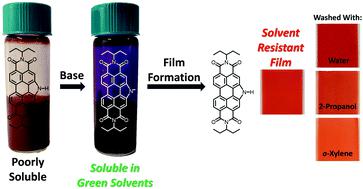当前位置:
X-MOL 学术
›
Mater. Horiz.
›
论文详情
Our official English website, www.x-mol.net, welcomes your feedback! (Note: you will need to create a separate account there.)
Acid dyeing for green solvent processing of solvent resistant semiconducting organic thin films
Materials Horizons ( IF 13.3 ) Pub Date : 2020-08-20 , DOI: 10.1039/d0mh00785d Cayley R. Harding 1, 2, 3, 4 , Jonathan Cann 1, 2, 3, 4 , Audrey Laventure 1, 2, 3, 4 , Mozhgan Sadeghianlemraski 4, 5, 6, 7 , Marwa Abd-Ellah 1, 2, 3, 4, 5 , Keerthan R. Rao 8, 9, 10, 11 , Benjamin Sidney Gelfand 1, 2, 3, 4 , Hany Aziz 4, 5, 6, 7 , Loren Kaake 1, 4, 12, 13 , Chad Risko 8, 9, 10, 11 , Gregory C. Welch 1, 2, 3, 4
Materials Horizons ( IF 13.3 ) Pub Date : 2020-08-20 , DOI: 10.1039/d0mh00785d Cayley R. Harding 1, 2, 3, 4 , Jonathan Cann 1, 2, 3, 4 , Audrey Laventure 1, 2, 3, 4 , Mozhgan Sadeghianlemraski 4, 5, 6, 7 , Marwa Abd-Ellah 1, 2, 3, 4, 5 , Keerthan R. Rao 8, 9, 10, 11 , Benjamin Sidney Gelfand 1, 2, 3, 4 , Hany Aziz 4, 5, 6, 7 , Loren Kaake 1, 4, 12, 13 , Chad Risko 8, 9, 10, 11 , Gregory C. Welch 1, 2, 3, 4
Affiliation

|
The alcohol and water-based processing of a perylene diimide (PDI) organic semiconductor into large area and solvent resistant films is reported. The compound, PDIN-H, is an N-annulated PDI dye with a pyrrolic NH functional group that can be deprotonated to render the material soluble in polar solvents. Addition of NaOH to mixtures of PDIN-H in 1-propanol results in a progressive color change from orange/red to purple with increasing equivalents of base. Use of 1 molar equivalent of NaOH was found to fully dissolve the PDIN-H in alcohol solvents up to a concentration of 10 mg mL−1. Primary alcohols 1-propanol to 1-hexanol as well as 2-propanol were used. All solutions were readily spin-coated or slot-die coated into uniform thin films. Solutions in 1-propanol could be coated with concentrations up to 50 mg mL−1. All films were red in color and characterized by optical absorption spectroscopy confirming the existence of the parent PDIN-H species in the film. Single crystal X-ray diffraction was used to determine the molecular packing of PDIN-H. Films showed no signs of dewetting, swelling, or dissolution upon exposure to 2-propanol, water, or o-xylene via coating or dipping indicating they were solvent resistant. To exploit the semiconducting properties of these PDIN-H films, organic photovoltaic devices were fabricated using the films as electron transport layers in inverted type P3HT:PC61BM bulk heterojunction devices. Moreover, the PDIN-H films changed from red to purple upon exposure to butylamine vapors which prompted the investigation of hydroxide free processing. Indeed, films of PDIN-H were easily formed by processing with 1-propanol/butylamine or water/butylamine solutions.
中文翻译:

耐溶剂半导体有机薄膜的绿色溶剂处理用酸性染料
报导了im二酰亚胺(PDI)有机半导体的醇和水基加工成大面积和耐溶剂膜。化合物PDIN-H是具有吡咯NH官能团的N环化PDI染料,可以将其去质子化,使材料可溶于极性溶剂中。将NaOH添加到PDIN-H在1-丙醇中的混合物中,随着碱的当量增加,颜色逐渐从橙色/红色变为紫色。发现使用1摩尔当量的NaOH将PDIN-H完全溶解在醇溶剂中直至浓度为10mg mL -1。使用伯醇1-丙醇至1-己醇以及2-丙醇。所有溶液都易于旋涂或缝模涂布成均匀的薄膜。1-丙醇溶液的包被浓度最高可达50 mg mL-1。所有薄膜均为红色,并通过光学吸收光谱法进行了表征,从而确认了薄膜中存在母体PDIN-H物种。用单晶X射线衍射测定PDIN-H的分子堆积。当薄膜通过涂布或浸涂而暴露于2-丙醇,水或邻二甲苯中时,没有显示出脱湿,溶胀或溶解的迹象,表明它们具有耐溶剂性。为了利用这些PDIN-H薄膜的半导体特性,使用该薄膜作为倒置型P3HT:PC 61中的电子传输层来制造有机光伏器件。BM本体异质结器件。此外,当暴露于丁胺蒸气中时,PDIN-H膜从红色变为紫色,这促使人们研究了无氢氧化物的加工方法。实际上,通过用1-丙醇/丁胺或水/丁胺溶液进行加工很容易形成PDIN-H膜。
更新日期:2020-09-01
中文翻译:

耐溶剂半导体有机薄膜的绿色溶剂处理用酸性染料
报导了im二酰亚胺(PDI)有机半导体的醇和水基加工成大面积和耐溶剂膜。化合物PDIN-H是具有吡咯NH官能团的N环化PDI染料,可以将其去质子化,使材料可溶于极性溶剂中。将NaOH添加到PDIN-H在1-丙醇中的混合物中,随着碱的当量增加,颜色逐渐从橙色/红色变为紫色。发现使用1摩尔当量的NaOH将PDIN-H完全溶解在醇溶剂中直至浓度为10mg mL -1。使用伯醇1-丙醇至1-己醇以及2-丙醇。所有溶液都易于旋涂或缝模涂布成均匀的薄膜。1-丙醇溶液的包被浓度最高可达50 mg mL-1。所有薄膜均为红色,并通过光学吸收光谱法进行了表征,从而确认了薄膜中存在母体PDIN-H物种。用单晶X射线衍射测定PDIN-H的分子堆积。当薄膜通过涂布或浸涂而暴露于2-丙醇,水或邻二甲苯中时,没有显示出脱湿,溶胀或溶解的迹象,表明它们具有耐溶剂性。为了利用这些PDIN-H薄膜的半导体特性,使用该薄膜作为倒置型P3HT:PC 61中的电子传输层来制造有机光伏器件。BM本体异质结器件。此外,当暴露于丁胺蒸气中时,PDIN-H膜从红色变为紫色,这促使人们研究了无氢氧化物的加工方法。实际上,通过用1-丙醇/丁胺或水/丁胺溶液进行加工很容易形成PDIN-H膜。


























 京公网安备 11010802027423号
京公网安备 11010802027423号